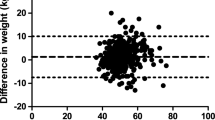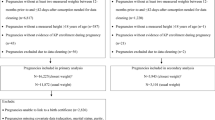Abstract
Objectives To examine clinical and demographic characteristics associated with availability of self-reported and measured pre-pregnancy weight, differences in these parameters, and characteristics associated with self-report accuracy. Methods Retrospective cohort of 7483 women who delivered at a large academic medical center between 2011 and 2014. Measured pre-pregnancy weights recorded within a year of conception and self-reported pre-pregnancy weights reported anytime during pregnancy were abstracted from electronic medical records. Difference in weights was calculated as self-reported minus measured pre-pregnancy weight. Logistic and linear regression models estimated associations between demographic and clinical characteristics, and presence of self-reported and measured weights, and weight differences. Results 42.2% of women had both self-reported and measured pre-pregnancy weight, 49.7% had only self-reported, and 2.8% had only measured. Compared to white women, black women and women of other races/ethnicities were less likely to have self-reported weight, and black, Asian, and Hispanic women, and women of other races/ethnicities were less likely to have measured weights. For 85%, pre-pregnancy BMI categorized by self-reported and measured weights were concordant. Primiparas and multiparas were more likely to underreport their weight compared to nulliparas (b = −1.32 lbs, 95% CI −2.24 to −0.41 lbs and b = −2.74 lbs, 95% CI −3.82 to −1.67 lbs, respectively). Discussion Utilization of self-reported or measured pre-pregnancy weight for pre-pregnancy BMI classification results in identical categorization for the majority of women. Providers may wish to account for underreporting for patients with a BMI close to category cutoff by recommending a range of gestational weight gain that falls within recommendations for both categories where feasible.

Similar content being viewed by others
References
American College of Obstetricians and Gynecologists. (2013). ACOG Committee opinion no. 549: Obesity in pregnancy. Obstetrics and Gynecology, 121(1), 213–217. doi:10.1097/01.AOG.0000425667.10377.60.
Burke, M. A., Heiland, F. W., & Nadler, C. M. (2010). From “overweight” to “about right”: Evidence of a generational shift in body weight norms. Obesity, 18(6), 1226–1234. doi:10.1038/oby.2009.369.
Finer, L. B., & Zolna, M. R. (2014). Shifts in intended and unintended pregnancies in the United States, 2001–2008. American Journal of Public Health, 104(Suppl 1), S43–S48. doi:10.2105/AJPH.2013.301416.
Headen, I., Mujahid, M. S., Cohen, A. K., Rehkopf, D. H., & Abrams, B. (2015). Racial/ethnic disparities in inadequate gestational weight gain differ by pre-pregnancy weight. Maternal and Child Health Journal, 19(8), 1672–1686. doi:10.1007/s10995-015-1682-5.
Holland, E., Simas, T. A., Curiale, D. K., Liao, X., & Waring, M. E. (2013). Self-reported pre-pregnancy weight versus weight measured at first prenatal visit: Effects on categorization of pre-pregnancy body mass index. Maternal and Child Health Journal, 17(10), 1872–1878. doi:10.1007/s10995-012-1210-9.
Huber, L. R. (2006). Validity of self-reported height and weight in women of reproductive age. Maternal and Child Health Journal, 11(2), 137–144. doi:10.1007/s10995-006-0157-0.
Institute of Medicine (US) and National Research Council (US) Committee to Reexamine IOM Pregnancy Weight Guidelines. (2009). In K. M. Rasmussen & A. L. Yaktine (Eds.) Weight gain during pregnancy: Reexamining the guidelines. Washington (DC): National Academies Press (US). Retrieved from http://www.ncbi.nlm.nih.gov/books/NBK32813/.
Kaar, J. L., Crume, T., Brinton, J. T., Bischoff, K. J., McDuffie, R., & Dabelea, D. (2014). Maternal obesity, gestational weight gain, and offspring adiposity: The exploring perinatal outcomes among children study. The Journal of Pediatrics, 165(3), 509–515. doi:10.1016/j.jpeds.2014.05.050.
Kabiru, W., & Raynor, B. D. (2004). Obstetric outcomes associated with increase in BMI category during pregnancy. American Journal of Obstetrics and Gynecology, 191(3), 928–932. doi:10.1016/j.ajog.2004.06.051.
Kistka, Z. A. -F., Palomar, L., Lee, K. A., Boslaugh, S. E., Wangler, M. F., Cole, F. S., et al. (2007). Racial disparity in the frequency of recurrence of preterm birth. American Journal of Obstetrics and Gynecology, 196(2), 131.e1–131.e6. doi:10.1016/j.ajog.2006.06.093.
Lindberg, S. M., & Anderson, C. K. (2014). Improving gestational weight gain counseling through meaningful use of an electronic medical record. Maternal and Child Health Journal, 18(9), 2188–2194. doi:10.1007/s10995-014-1467-2.
Martin, J. A., Hamilton, B. E., Osterman, M. J., Curtin, S. C., & Matthews, T. J. (2015). Births: Final data for 2013. National Vital Statistics Reports, 64(1), 1–65.
Merrill, R. M., & Richardson, J. S. (2009). Validity of self-reported height, weight, and body mass index: findings from the National Health and Nutrition Examination Survey, 2001–2006. Preventing Chronic Disease, 6(4), A121.
Moore Simas, T. A., Waring, M. E., Sullivan, G. M. T., Liao, X., Rosal, M. C., Hardy, J. R., & Berry, R. E. (2013). Institute of medicine 2009 gestational weight gain guideline knowledge: Survey of obstetrics/gynecology and family medicine residents of the United States. Birth, 40(4), 237–246. doi:10.1111/birt.12061.
Ogden, C. L., Carroll, M. D., Kit, B. K., & Flegal, K. M. (2014). Prevalence of childhood and adult obesity in the United States, 2011–2012. JAMA, 311(8), 806–814. doi:10.1001/jama.2014.732.
Oken, E., Switkowski, K., Price, S., Guthrie, L., Taveras, E. M., Gillman, M., et al. (2013). A qualitative study of gestational weight gain counseling and tracking. Maternal and Child Health Journal, 17(8), 1508–1517. doi:10.1007/s10995-012-1158-9.
Oken, E., Taveras, E. M., Kleinman, K. P., Rich-Edwards, J. W., & Gillman, M. W. (2007). Gestational weight gain and child adiposity at age 3 years. American Journal of Obstetrics and Gynecology,196(4), 322.e1–322.e8. doi:10.1016/j.ajog.2006.11.027.
Shin, D., Chung, H., Weatherspoon, L., & Song, W. O. (2014). Validity of prepregnancy weight status estimated from self-reported height and weight. Maternal and Child Health Journal, 7, 1667–1674.
Siega-Riz, A. M., Viswanathan, M., Moos, M.-K., Deierlein, A., Mumford, S., Knaack, J., et al. (2009). A systematic review of outcomes of maternal weight gain according to the Institute of Medicine recommendations: Birthweight, fetal growth, and postpartum weight retention. American Journal of Obstetrics and Gynecology, 201(4), 339.e1–339.e14. doi:10.1016/j.ajog.2009.07.002.
Smith, D. M., Cooke, A., & Lavender, T. (2012). Maternal obesity is the new challenge; a qualitative study of health professionals’ views towards suitable care for pregnant women with a Body Mass Index (BMI) ≥ 30 kg/m2. BMC Pregnancy and Childbirth, 12, 157. doi:10.1186/1471-2393-12-157.
Viswanathan, M., Siega-Riz, A. M., Moos, M. K., Deierlein, A., Mumford, S., Knaack, J., et al. (2008). Outcomes of maternal weight gain. Evidence Report/Technology Assessment, 168, 1–223.
Waring, M. E., Moore Simas, T. A., Rosal, M. C., & Pagoto, S. L. (2015). Pregnancy intention, receipt of pre-conception care, and pre-conception weight counseling reported by overweight and obese women in late pregnancy. Sexual & Reproductive Healthcare, 6(2), 110–111. doi:10.1016/j.srhc.2015.01.006.
Yu, S. M., & Nagey, D. A. (1992). Validity of self-reported pregravid weight. Annals of Epidemiology, 2(5), 715–721.
Acknowledgements
Partial support for Dr. Waring provided by National Institutes of Health Grant Nos. KL2TR000160 and U01HL105268.
Author information
Authors and Affiliations
Corresponding author
Rights and permissions
About this article
Cite this article
Bannon, A.L., Waring, M.E., Leung, K. et al. Comparison of Self-reported and Measured Pre-pregnancy Weight: Implications for Gestational Weight Gain Counseling. Matern Child Health J 21, 1469–1478 (2017). https://doi.org/10.1007/s10995-017-2266-3
Published:
Issue Date:
DOI: https://doi.org/10.1007/s10995-017-2266-3




